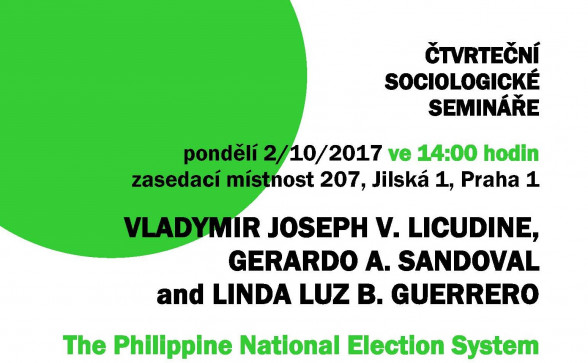Sociologický ústav AV ČR, v.v.i., a katedra sociologie Institutu sociologických studií FSV UK si Vás dovolují pozvat na podzimní cyklus Čtvrtečních sociologických seminářů.
Vladymir Joseph V. Licudine - Monitoring Voter Preferences in Pre-election surveys
Gerardo Sandoval - Tracking voter sentiments and behavior using panel mobile surveys
Linda Luz B. Guerrero - Reporting election results during day-of- election poll
Following the restoration of democracy under President Corazon Aquino in February 1986, there have been national elections for President and Vice-President in 1992, 1998 and 2004, 2010 and 2016 and for Senators in 1987, 1992, 1995, 1998, 2001, 2004, 2007, 2010 and 2016.
The President and Vice-President are directly and separately elected by the national electorate. Separate voting for the positions of President and Vice-President makes it possible for the winners to come from different political parties, as in fact happened in 1992, 1998, 2010 and 2016 while in 2004, the President and Vice-President were both from the Administration. Since politicians change parties easily, voters are much more loyal to personalities than to parties. There is also one round of voting, so when there are more than 2 candidates, the winner often has plurality of the votes cast.
The election of Senators in the Philippines is unique, with no geographical allocation of seats. Senators are elected at large and wage a national electoral campaign, making a high-scoring senatorial winner a strong contender for a future presidential or vice-presidential position. Twenty-four seats were contested in 1987 and 1992, and 12 seats every three years thereafter. Thus the winners were the top 24 candidates in 1987 and 1992, and the top 12 in elections starting in 1995, in terms of the national number of votes. At present, a voter may choose up to 12 names, and may split the choice across any number of political parties. Voters usually select a mix of senatorial candidates from different parties, so a political party is said to win a senatorial election if most of the winners are affiliated with it. The outcome of a senatorial election is inherently more difficult to predict, since the percentage-point difference in votes between the lowest-ranked winner and the highest-ranked loser is often only a fraction of a percentage point.
The fact that the Philippines is the country most developed, within the ASEAN region, in terms of opinion polling is a sign of the vigor of its democracy. The most important reason for the acceptance of opinion polling in the Philippines is probably the success of surveys in predicting the outcomes of the national elections in the past decade.
As an important political activity affecting the country, Social Weather Stations (SWS) conducts surveys during the election period. For the May 2016 elections, SWS used 3 approaches to study voting preferences and behavior: 1) Pre-election surveys, 2) Panel mobile surveys, and 3) Exit polls.
1. Pre-election surveys. Implemented using face-to-face paper and pencil interviews-- the reliable and primary survey mode used by SWS-- the monthly pre-election surveys of statistically representative national sample of voters measured, among others, the awareness, trust and voting intentions for candidates, demographics of intended votes, traits desired of candidates, awareness of campaigns, issues affecting votes and vote commitment. Vladymir Joseph V. Licudine will discuss these is his talk about "Monitoring Voter Preferences in Pre-election surveys".
2. Panel mobile surveys. First implemented in the Philippines in the first half of 2016 as the country headed into general elections, the Bilang Pilipino (Count Filipino) SWS Mobile Survey was a pioneering effort to utilize mobile digital technology for scientific, rapid opinion tracking of a statistically representative national panel of voters freely equipped with mobile phones. Gerardo Sandoval will discuss the methodology and results is his talk about "Tracking voter sentiments and behavior using panel mobile surveys".
3. Exit poll. The SWS exit polls of 1995, 1998, 2001 and 2004 were all conducted on election-day, in the homes of a random sample of respondents who had already voted earlier in the day. In 2010 and 2016, however, the SWS exit polls were conducted not in homes but at fifty (50) meters away from the polling centers. In addition to asking about the votes for President, Vice-President and Senators, several questions and standard demographics (gender, age, education, socioeconomic class, religion, charismatic group, and home language) were asked that enabled substantive analysis of the 2016 vote. Linda Luz B. Guerrero will discuss the methodology and results in her talk about "Reporting election results during day-of- election poll".
Vladymir Joseph V. Licudine is Deputy Director Survey Design, Analysis and Training, Gerardo A. Sandoval is Director Sampling and Data Processing, and Linda Luz B. Guerrero is concurrently Vice-President/COO and Director of Survey Design, Analysis and Training of Social Weather Stations (SWS,https://www.sws.org.ph/swsmain/home/ ). Established in 1985, SWS is a private, non-stock, non-profit and non-partisan social research institution engaged in public opinion polling in the Philippines. SWS conducts omnibus national surveys of the general Filipino public, initially semi-annually from 1986, but quarterly since 1992. On top of these surveys, SWS also conducts commissioned surveys on various socio-economic and political issues.
Seminář je pořádán v rámci projektu CSDA Research s podporou Operačního programu Výzkum, vývoj a vzdělávání (reg. č. projektu CZ.02.1.01/0.0/0.0/16_013/0001796).


Facebook
X
Tweets by SociologickyNewsletter